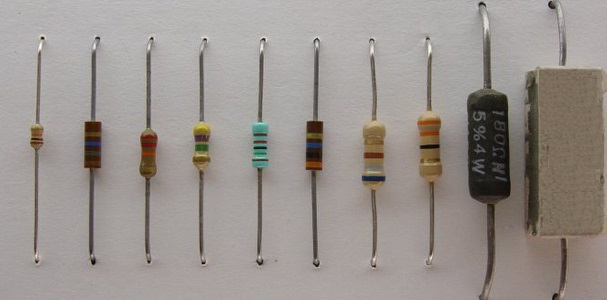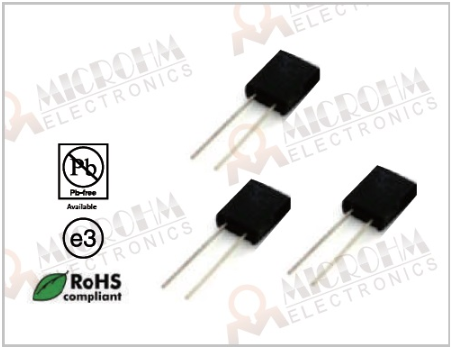Position:Home » Technical Articles
Considerations for choosing precision resistors
Writer:Microhm Page View:Date:2020-01-16
Precision resistor generally refers to a resistor whose value is 1 percent, 0.5 percent or even lower. The percentage will be clearly stated in an unambiguous manner. However, this is only the starting point, as the actual resistance of a 1 percent, 100-ohm resistor is guaranteed to be between 95 ohms and 105 ohms only under ideal conditions. But real-world designs must function under real-world conditions.
Voltage
The Voltage Coefficient of Resistance (VCR) is the change in resistance with applied voltage. This is entirely different and in addition to the effects of self-heating when power is applied. A resistor with a VCR of 100 ppm/V will change 0.1 percent over a 10-Volt change and 1 percent over a 100-Volt change.

Temperature and Power
Electronic devices often have to operate in high-temperature environments, so it is vital to know how the resistor you choose will behave with variations in temperature. The Temperature Coefficient of Resistance (TCR) is specified as the change in resistance, in parts per million (ppm), for a change in temperature of one degree. The value is usually specific for degrees Celsius, as opposed to the Fahrenheit. Closely related to the TCR is the Power Coefficient of Resistance (PCR), because the temperature changes in a resistor are closely related to the amount of power dissipated.
Changes due to TCR are reversible; when power is turned off and the resistor cools back down to room temperature, the resistor’s value returns to normal. But, over the longer term, the temperature under which the resistor operates can also cause permanent changes in a resistor’s value. The effect varies with resistor technology, and it can usually be predicted in advance based on information supplied by the manufacturer.
Especially Precision Resistors
There are many factors precision resistors share with all resistors that are, perhaps, more important for the former simply because they don’t often factor in with applications that can tolerate 10 or 20 percent variation, but can be devastating in an application requiring higher fidelity.
Every resistor is rated by the maximum power it can dissipate, but the stated amount of safe power dissipation is derated by how far the temperature of the resistor deviates from ambient room temperature. A good spec sheet for any precision resistor will include a graph specifying the fall-off.
Resistor noise can be thought of as tiny, random electrical signals emanating from a resistor. This can be intolerable to designs that measure low-level analog signals. Also, the value of resistors can change over time, and in response to many sorts of environmental stress, with power dissipation and heat being the usual malefactors.

Technologies
There are many different types of resistors on the market today and some types are better suited than others to specific challenges when high precision, high stability, are required. Generally speaking, precision metal film resistors perform well on this basis. Microhm Electronics' NLT series exhibit TCRs as low as 1 ppm and the tolerance down to 0.01%.
Specifying a precision resistor can be a daunting task, and they are not inexpensive. The designer needs to completely understand the environmental stresses the final product will need to survive, and carefully study the datasheets offered by reputable manufacturers, such as Microhm Electronics.
Voltage
The Voltage Coefficient of Resistance (VCR) is the change in resistance with applied voltage. This is entirely different and in addition to the effects of self-heating when power is applied. A resistor with a VCR of 100 ppm/V will change 0.1 percent over a 10-Volt change and 1 percent over a 100-Volt change.

Temperature and Power
Electronic devices often have to operate in high-temperature environments, so it is vital to know how the resistor you choose will behave with variations in temperature. The Temperature Coefficient of Resistance (TCR) is specified as the change in resistance, in parts per million (ppm), for a change in temperature of one degree. The value is usually specific for degrees Celsius, as opposed to the Fahrenheit. Closely related to the TCR is the Power Coefficient of Resistance (PCR), because the temperature changes in a resistor are closely related to the amount of power dissipated.
Changes due to TCR are reversible; when power is turned off and the resistor cools back down to room temperature, the resistor’s value returns to normal. But, over the longer term, the temperature under which the resistor operates can also cause permanent changes in a resistor’s value. The effect varies with resistor technology, and it can usually be predicted in advance based on information supplied by the manufacturer.
Especially Precision Resistors
There are many factors precision resistors share with all resistors that are, perhaps, more important for the former simply because they don’t often factor in with applications that can tolerate 10 or 20 percent variation, but can be devastating in an application requiring higher fidelity.
Every resistor is rated by the maximum power it can dissipate, but the stated amount of safe power dissipation is derated by how far the temperature of the resistor deviates from ambient room temperature. A good spec sheet for any precision resistor will include a graph specifying the fall-off.
Resistor noise can be thought of as tiny, random electrical signals emanating from a resistor. This can be intolerable to designs that measure low-level analog signals. Also, the value of resistors can change over time, and in response to many sorts of environmental stress, with power dissipation and heat being the usual malefactors.

Technologies
There are many different types of resistors on the market today and some types are better suited than others to specific challenges when high precision, high stability, are required. Generally speaking, precision metal film resistors perform well on this basis. Microhm Electronics' NLT series exhibit TCRs as low as 1 ppm and the tolerance down to 0.01%.
Specifying a precision resistor can be a daunting task, and they are not inexpensive. The designer needs to completely understand the environmental stresses the final product will need to survive, and carefully study the datasheets offered by reputable manufacturers, such as Microhm Electronics.
Keywords:
Latest News
- Resistor's role in measuring and correcting LED,,,
- Single through-hole resistors' characteristics ,,,
- Why shunt resistors for current sense applicati,,,
- Metal-film resistors with small size, high resi,,,
- 36W High-Current Shunt Resistors MMS8420,,,
- 1W Surface Mount Resistor MPR1206,,,
- An Overview of Microhm Electronics' Resistor Pr,,,
- More anti-sulfur resistors used in harsh envir,,,
- Resistance changes with temperature,,,
- 140W TO247 High Power Heatsinkable Resistor,,,
- MMS5930 is ideal for current sensing in industr,,,
- Shunt resistors selection for engineers' design,,,
- Considerations for choosing precision resistors,,,
- Ceramic Encased Cement Resistors NWH Series for,,,
- Resistors for Passive Balancing in Battery-Pow,,,
Hot Articles
- Microhm will take part in 10th Automotive World,,,
- Thanks for Visiting Microhm's Booth E5-5706 in ,,,
- Resistors in Short Supply: Blame Cars,,,
- New lunch: High Power Precision Shunt Resistor,,,,
- How to Test a Resistor,,,
- Innovative Technology, Future Electric: Electri,,,
- What is Precision Resistors?,,,
- SMD Resistors Sizes and Packages,,,
- The Construction and Features of Metal Film Res,,,
- What is a TO-220 Resisor?,,,
- Hot Selling Products: Precision Shunt Resistors,,,
- How to Calculate the Equivalent Resistance Valu,,,
- What is a Fixed Resistor?,,,
- Resistors in LED Circuits,,,
- Resistors Types and Materials Overview,,,
Resistance applications
- The Measurement Accuracy of Automotive Shunt is,,,
- The Four Important Functions of Alloy Resistors,,,
- Miniature future for passive electronic compone,,,
- Industrial Roberts Applied to Solar Photovoltai,,,
- Urbanization Development Bringing the Transform,,,
- The Main Application for High Precision and Low,,,
- Surface Mount Resistor's Size and Package ,,,
- Why Zero-Ohm Resistors?,,,
- Carbon Film Resistors' Features and Application,,,
- Select the Right Resistor for Harmonic Filterin,,,
- Precision Resistors' Construction and TCR,,,
- Difference Between High Precision Resistors and,,,
- Heater Blower Motor Resistor in Air Conditioner,,,
- BMS for New Energy Vehicle,,,
- Shunt Resistor MMS8420 for High Current Stable ,,,
